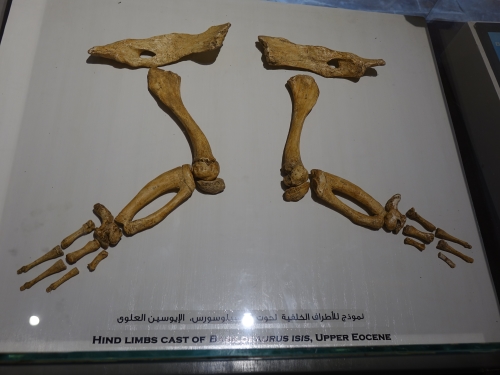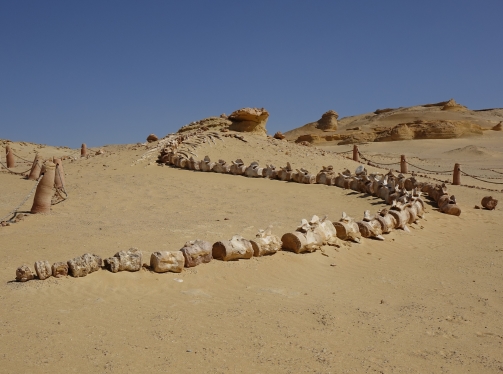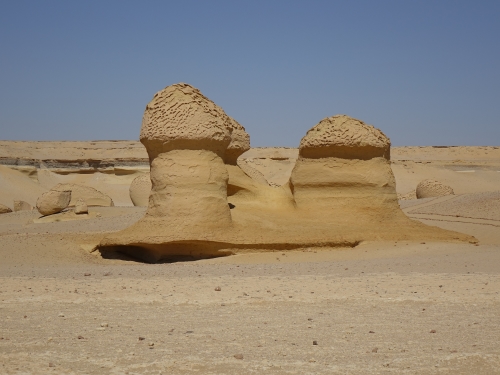Blog WHS Visits
WHS #688: Wadi al-Hitan
Wadi Al-Hitan (the Whale Valley) is “the most significant site in the world to demonstrate the evolution of whales”. The valley lies 190km south of Cairo in Egypt’s Al Fayoum area, to which the Dutch foreign travel advice still applies the label “necessary travel only”. Well – it was necessary for me! There is no reason to avoid this region nowadays. Large tour groups are assigned escorts according to the Lonely Planet – and indeed we met a tourist convoy of 4x4’s accompanied by armed police. I was with a local driver (who seemed to know everybody) and we were just waved on at the only checkpoint near Lake Qarun.

In the early morning I was picked up at my Cairo hotel with a 4WD jeep. Due to the busy traffic, getting out of (and into) Cairo is quite time-consuming. Once outside the city limits we hardly saw anyone anymore. The road has been completely paved up to the last 32km, but occasionally some sand hills have blown over the road and a 4WD (or just high clearance) is helpful. The final stretch is on a reinforced sand road. My driver found it more fun to drive off-road though.
Some 3 hours after our departure we arrived at the Wadi. This is one of the most modern and best organized attractions in Egypt. There is a demarcated parking space, a café, clean toilets and a brand new museum. All these outbuildings are made in an adobe style so that they fit exactly within the landscape. Entrance costs 40 Egyptian pounds (2 EUR). Only since 1983 has research been done on a large scale and has the importance of these fossils been discovered. In 2005 it became a WHS and since then it has been made accessible to visitors. This has been done with Italian technical and financial support, via a twinning agreement between Wadi Al-Rayan (the national park in which the whale fossils lie) and Italy’s Gran Sasso National Park.
We started our tour at the Fossil and Climate Change museum, only open since 2016. It is small but does its job of explaining the importance of the site well. The largest whale species found on site is the now extinct Basilosaurus isis, which still had small hind legs but they were not strong enough to stand on anymore. In the museum they do have a full skeleton of this species. You can also see fossilized plants and shells. There is even a fossil of a watermelon!

You can only enter the fossil area on foot, via a hiking trail of about 2km length. Fortunately, it was a bit windy the day that I visited - walking through the sand in the burning sun otherwise would be quite a test. I noticed a guide from a Spanish group pointing the start of the trail out to them and immediately returning to the shelter of the café himself. My guide went along, but had little added value on this trip. From the main trail there are numbered signs pointing to side paths where you can see a fossil or something else of interest. Although there is also a complete skeleton, mainly spines from the whale fossils can be seen.
The fossils lie in the open air - we wondered what happens to them when there is a sandstorm or when it rains (if it ever rains here). Probably they are somehow fastened to the soil at the bottom. When this area was under water and the whales lived here, this valley was a coastal area with mangroves. You can see these plants as well fossilized in the landscape. Further down the valley, the number of whale fossils decreases but the landscape becomes more and more beautiful. There are strangely eroded hills, like giant mushrooms. We walked almost the entire path, except for the last hill with a mysterious sign 'Exit' - you really have to return the same way though as you came.

From Cairo this is a full day trip: I left at 7:30 and was back at the hotel at 6 o'clock. The visit to the valley itself took about 2 hours. The landscape is beautiful and the story behind the whale fossil findings I found intriguing. This side trip is also a nice change from busy Cairo and the many monuments from Egyptian antiquity. On both ways we passed Lake Qarun, part of the TWHS that is up for a separate nomination in 2020. Especially from the western side this huge lake suddenly appears as an oasis in the desert.
Els - 17 November 2018